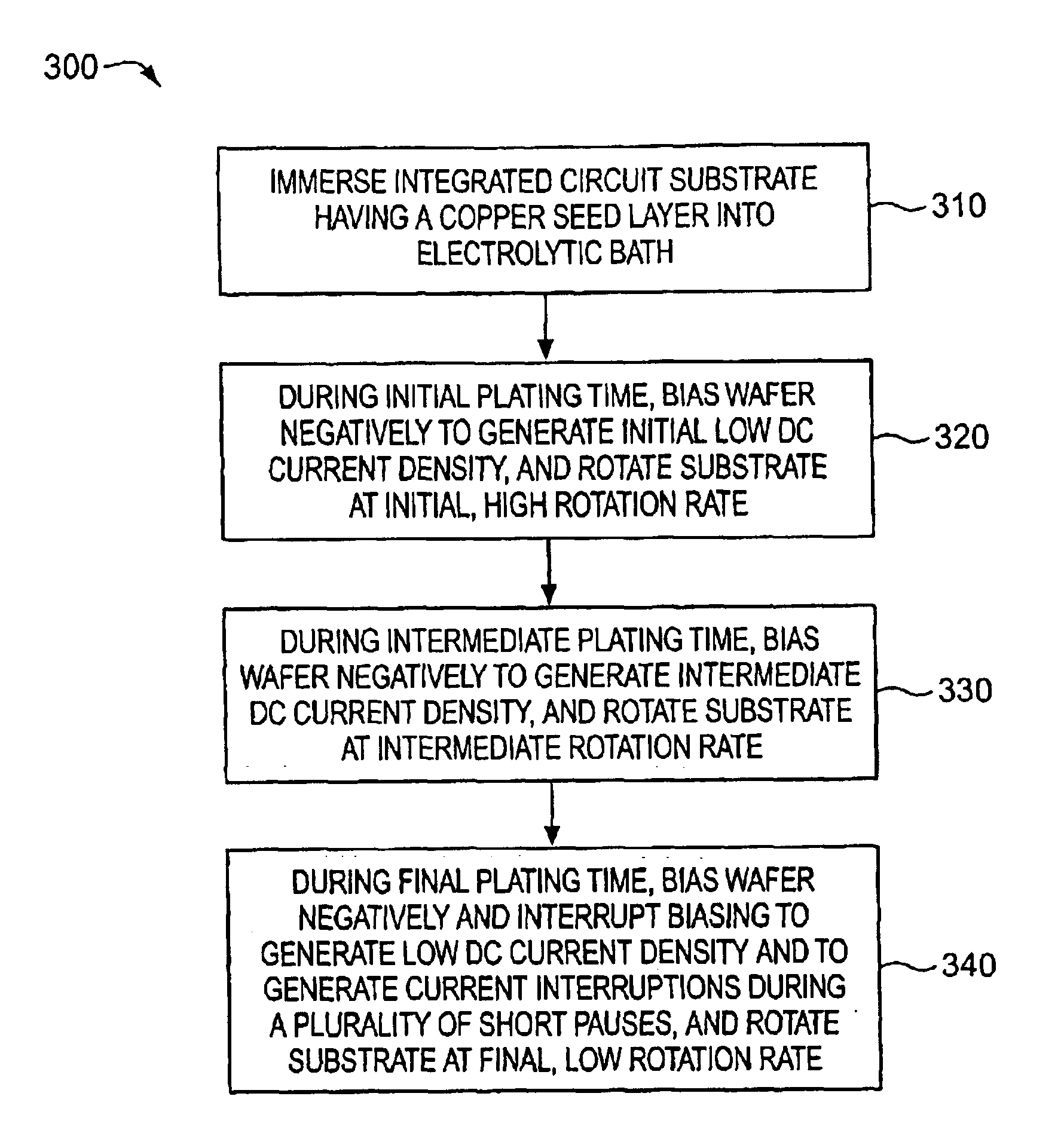Electroplating using DC current interruption and variable rotation rate
a technology of dc current interruption and electroplating, which is applied in the direction of transportation and packaging, other domestic articles, coatings, etc., can solve the problems of difficult measurement of defects on copper deposits, interference with the ability to identify accurately device-killing defects, and inability to accurately identify defects in electroplating techniques. , to achieve the effect of reducing protruding defects, reducing defects in electroplated metal, and reducing defects
- Summary
- Abstract
- Description
- Claims
- Application Information
AI Technical Summary
Benefits of technology
Problems solved by technology
Method used
Image
Examples
example 1
[0040]A method in accordance with the invention was conducted using a Novellus Model Sabre xT apparatus to deposit copper on an integrated circuit substrate wafer. Process specifications of a standard Sabre xT copper DC electrofill process as known in the art were modified by interrupting biasing in accordance with the invention. A 200 mm silicon wafer having a copper seed layer with a thickness of approximately 100 nm was plated with copper using a standard copper plating solution. The plating solution contained: 40 grams per liter (“g / l”) of dissolved copper metal, added as copper sulfate pentahydrate (CuSO4.5H2O); 10 g / l H2SO4; 50 milligrams per liter (mg / l) chloride ion, added as HCl; 6 milliliters per liter (ml / l) Viaform accelerator; 2 ml / l Viaform suppressor; and 2.5 ml / l Viaform leveler. The Viaform accelerator, suppressor, and leveler are commercially available from Enthone Company. Copper plating was conducted at room temperature, that is, at about 25° C. The plating solut...
example 2
[0051]A copper layer having a thickness of 0.7 μm, or 700 nm, was electroplated on a series of wafers using Waveform 2 as implemented in Example 1 above, but the rotation rate of the wafer was varied during electroplating. During the intermediate plating time of Waveform 2, each substrate wafer was rotated at a speed selected from 10, 25, 50, and 75 rpm. During the final 3rd-step plating time, each substrate wafer was rotated at a speed selected from 10, 25, and 50 rpm. Defects were measured as described in Example 1. FIG. 5 shows a graph in which measured defect count is plotted as a function of intermediate 2nd-step rotation rate. The results show that the 2nd-step rotation rate did not have a substantial effect on protrusion-defect counts. In contrast, there is a correlation between 3rd-step rotation rate and defect count. A copper layer fabricated using a final 3rd-step rotation rate of 10 rpm generally has a lower defect count than copper layers fabricating using a final 3rd-st...
example 3
[0052]A copper layer having a thickness of 0.7 μm, or 700 nm, was electroplated on a series of wafers as in Example 1, but using various combinations of DC current waveforms and varied rotation rates in accordance with the invention. Defects were measured as described in Example 1.
[0053]FIG. 6 contains a graph in which defect count is plotted as a function of a particular combination of waveform and 2nd-step and 3rd-step rotation rates. The first set of bars plotted at the left of the graph of FIG. 6 represents defect counts in copper layers fabricating using the conventional POR of Table 1 and a standard rotation rate of 125 rpm. The second set of bars from the left represents defect counts of copper layers formed using Waveform 2 of Table 1 in accordance with the invention, without varying the standard rotation rate of 125 rpm. The third set of bars from the left represents defect counts of copper layers formed using Waveform 1 of Table 1, in accordance with the invention, without...
PUM
| Property | Measurement | Unit |
|---|---|---|
| current density | aaaaa | aaaaa |
| current density | aaaaa | aaaaa |
| current density | aaaaa | aaaaa |
Abstract
Description
Claims
Application Information
 Login to View More
Login to View More - R&D
- Intellectual Property
- Life Sciences
- Materials
- Tech Scout
- Unparalleled Data Quality
- Higher Quality Content
- 60% Fewer Hallucinations
Browse by: Latest US Patents, China's latest patents, Technical Efficacy Thesaurus, Application Domain, Technology Topic, Popular Technical Reports.
© 2025 PatSnap. All rights reserved.Legal|Privacy policy|Modern Slavery Act Transparency Statement|Sitemap|About US| Contact US: help@patsnap.com



